Anya Ulinich’s “Lena Finkle’s Magic Barrel” (Penguin 2014), a graphic novel for adults will 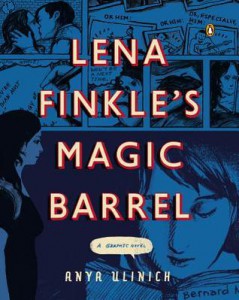 also be popular with young adults. The story of Lena, a 17 year old Russian immigrant moving with her parents to Arizona in the 80s, appears to be Ulinich’s thinly disguised memoir.
also be popular with young adults. The story of Lena, a 17 year old Russian immigrant moving with her parents to Arizona in the 80s, appears to be Ulinich’s thinly disguised memoir.
The “magic barrel” seems to be the burden of her lovers, the first being her Russian high school sweetheart Alik, who she loves “thanks to his Heathcliff schtick.” At 35, Lena is on a book tour to Russia (so was Ulinich). Alik shows up and the miniature “immigrant soul” appears and says. “Oh-Oh. The brain area that reacts to sad Russian men has been activated.” Alik, in spite of now being married to a Russian woman, suggests that he and Lena grow old together. She tells him it’s against the law in the U.S. to be old. At 35?
Ulinich gives a view of American culture seen through immigrant eyes. It is often hilarious as well as eye-opening.
With a good deal of flashback to her Russian upbringing, she informs us about the sad state of sex education during perestroika or “restructuring”—the Gorbachev years. Which sets us up for Lena’s two disastrous marriages stateside.
Upon arrival to Phoenix, Arizona, the synagogue “supports” the family by giving them “Jew Bags”—Lena’s includes size 11 green sneakers and Sylvia Plath’s “The Bell Jar”. The whole family is in effect indentured servants to U.S. families. Lena meets Chance who says, “So you’re Russian?” and she corrects him. “I’m from Russia. I’m a Jew.” She tells us only Soviets understand that. And it clarifies that cultural schism for me.
Chance calls her Anne Frank, teaches her about American culture, ridicules her, and asks why she won’t sleep with him. Answer: Because she’s serious about her virginity. No sex until she marries. So she marries Chance, gets a green card, and says “I have narrowly escaped becoming a Hasidic Wife, but that other woman whoever she is, dying of emphysema in a trailer park forty years from now—she is not me either.” They divorce.
Lena attends Arizona State and meets Josh. The complex Venn diagram and Relationship Map, showing how they’re meant for each other is hysterical. They marry have two girls and divorce (as does Ulinich). At this point Lena begins on-line dating, offers insightful, dark, funny opinions on the “gender war.” How can anyone be so honest in print (and drawing). She self-deprecates, showing herself as hideous, but she gets pretty. She loses and gains weight (in the drawings) without saying much about it.
There’s sex—not graphic or sensationalized—but honest. Even if a teen reader is (probably) not married, their parents might be and there are some fascinating insights into that institution. And love. And heartbreak. The drawings are frequently remarkable paintings. I love this book for many ages.
Patricia Hruby Powell’s new book Josephine: The Dazzling Life of Josephine Baker won a Boston Globe Horn Book 2014 Honor for Nonfiction and a Parents Choice Gold Award for Poetry.
 in her soul. From an early age, she was happiest when performing in front of an appreciative audience. Because of her race, she was often relegated to dressing the dancers, but Josephine worked hard and learned all the dance moves, just in case. When she got the chance to perform on stage, she took it, eventually catching the eye of a benefactor who invited her to perform in Paris, where she stepped into the spotlight and became a star across Europe. Through her bold performances and natural fearlessness she ultimately pushed through the boundaries of segregation in America to become an international performing star. The unadorned narration of the blank verse text is lovely and vibrantly read by veteran actress Lizan Mitchell. Her voice is full of the same energy and verve Josephine embodied. The text is mostly narrative and no dialog, sprinkled with occasional quotes from Josephine herself. Mitchell fluidly reads the lovely verse, “knees squeeze, now fly/arms scissors and splay,” that captures Josephine’s uninhibited nature so well. Jennifer Berberugge State Library Services Roseville MN
in her soul. From an early age, she was happiest when performing in front of an appreciative audience. Because of her race, she was often relegated to dressing the dancers, but Josephine worked hard and learned all the dance moves, just in case. When she got the chance to perform on stage, she took it, eventually catching the eye of a benefactor who invited her to perform in Paris, where she stepped into the spotlight and became a star across Europe. Through her bold performances and natural fearlessness she ultimately pushed through the boundaries of segregation in America to become an international performing star. The unadorned narration of the blank verse text is lovely and vibrantly read by veteran actress Lizan Mitchell. Her voice is full of the same energy and verve Josephine embodied. The text is mostly narrative and no dialog, sprinkled with occasional quotes from Josephine herself. Mitchell fluidly reads the lovely verse, “knees squeeze, now fly/arms scissors and splay,” that captures Josephine’s uninhibited nature so well. Jennifer Berberugge State Library Services Roseville MN telling the complex Russian history through the eyes of both nobility and peasantry.
telling the complex Russian history through the eyes of both nobility and peasantry.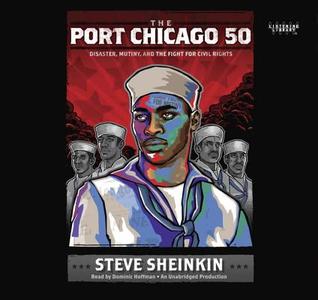 freedom. In “The Port Chicago 50: Disaster, Mutiny, and the Fight for Civil Rights” (Roaring Brook 2014) Steve Sheinkin paints a picture of the segregated armed forces. Rather than being assigned to battle, blacks worked in the mess hall. Or worse.
freedom. In “The Port Chicago 50: Disaster, Mutiny, and the Fight for Civil Rights” (Roaring Brook 2014) Steve Sheinkin paints a picture of the segregated armed forces. Rather than being assigned to battle, blacks worked in the mess hall. Or worse. Here’s her entry:
Here’s her entry: 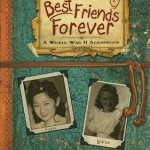 And then Beverly Patt who wrote the fascinating Best Friends Forever: A WWII Scrapbook, cleverly formatted as a scrap book. Here’s here entry:
And then Beverly Patt who wrote the fascinating Best Friends Forever: A WWII Scrapbook, cleverly formatted as a scrap book. Here’s here entry: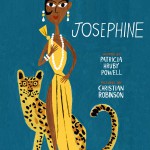
 I’ve just revised a razz-ma-tazz picture book biography, Struttin’ With Some Barbecue: Lil Hardin Armstrong about the jazz pianist and composer married to Louis Armstrong in the 1920s.
I’ve just revised a razz-ma-tazz picture book biography, Struttin’ With Some Barbecue: Lil Hardin Armstrong about the jazz pianist and composer married to Louis Armstrong in the 1920s.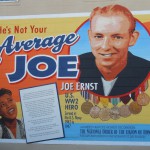 who served a bus full of black people at a roadside restaurant. Turned out it was Ella Fitzgerald and her band.
who served a bus full of black people at a roadside restaurant. Turned out it was Ella Fitzgerald and her band. Way Home and Dogs of Winter. I can’t wait to hear about her process.
Way Home and Dogs of Winter. I can’t wait to hear about her process.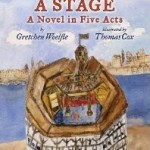 Stage: A Novel in 5 Acts. Terrific. I love all her books, the latest being Mumbet’s Declaration of Independence. Get a preview here http://www.gretchenwoelfle.com/all_the_world_s_a_stage__a_novel_in_five_acts_113204.htm
Stage: A Novel in 5 Acts. Terrific. I love all her books, the latest being Mumbet’s Declaration of Independence. Get a preview here http://www.gretchenwoelfle.com/all_the_world_s_a_stage__a_novel_in_five_acts_113204.htm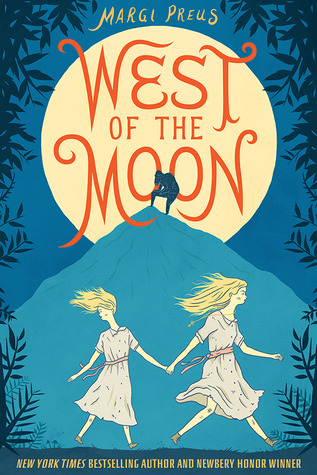 Scandinavian folktales. Superstitions are alive and alluring—with the invisible and wicked huldrefolks lurking near cradles and under bridges.
Scandinavian folktales. Superstitions are alive and alluring—with the invisible and wicked huldrefolks lurking near cradles and under bridges.